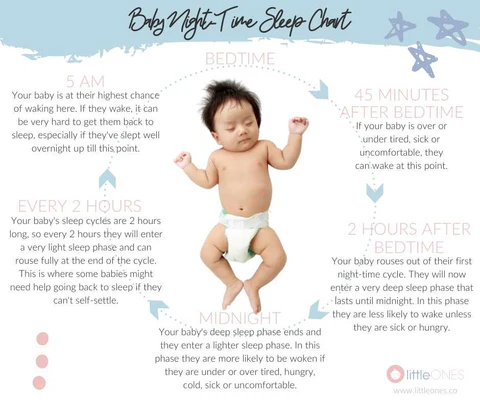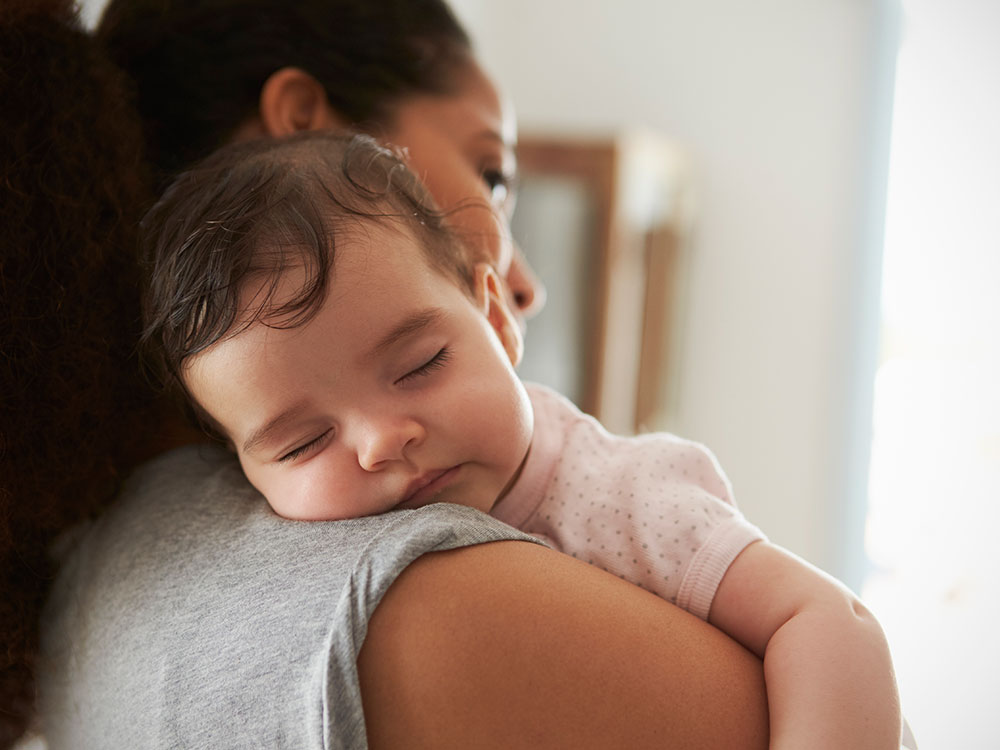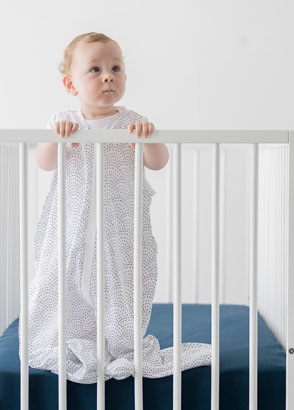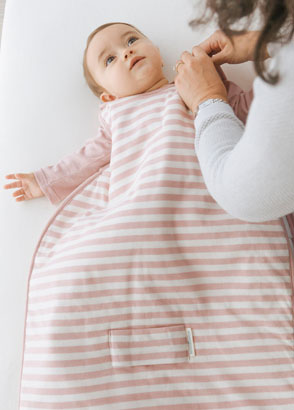 9 Amazing Baby Sleep Tips for Night Waking - The Military Wife and Mom
9 Amazing Baby Sleep Tips for Night Waking - The Military Wife and MomYour cart Everyone talks about self-sent... but why is it important? Why do you bother teaching your baby to set you up at bedtime? Why don't you keep feeding or shaking your baby to sleep? If you are happy with how much sleep you and your baby are currently receiving, then don't read more! But if your baby needs more sleep during the night or catnaps and is constantly over-tired during the day, then learning to self-conciling will probably make a big difference to your baby's dream and general well-being. If your own physical or mental health is suffering as a result of sleeplessness, we strongly recommend that you start helping your baby learn how to fix you. For example, Australian research showed a significant number of cases of postnatal depression can be resolved quickly by teaching the baby to sleep. Continuous exhaustion makes life with a stressful baby and often is not very fun. Sleep deprivation can affect all relationships, their ability to parent and work, their perspective and enjoyment of life with their baby. We think it's okay to want a decent dream once your baby is well spent on the newborn stage... it doesn't make you selfish! Teaching or encouraging your baby to self-conciling will mean more sleep for everyone and certainly does not mean using believe it... we do not recommend that at all! IndexWhen does self-responsiveness become important? Once all babies are about 5 months old, their sleep cycles will change considerably. Instead of spending the dream all night, babies start to wake up completely between sleep cycles. So all babies start to wake up 4-6 times, or more, every night. So babies over 5 months don't really 'sep through' - if they can auto-settle, they can go back to sleep 4-6 times during the night without their help. But if your baby can't sleep without your help at bedtime, he's likely to need your help getting back to sleep every time he wakes up at night. Usually babies want or need the same settlement technique during the night they trust in bedtime to sleep. So if you feed your baby to sleep in bed, it's gonna look like nothing other than feeding you to sleep will fix them at night! Babies who continue to be helped to sleep at bedtime and through the night develop a dependency, or habit, with such help. In the following months, your night waking often gets worse instead of better as they grow. All babies, children and adults stir and wake up many times at night. But you can encourage your baby to sleep again without needing your help, and this is when your baby 'sleve through the night'. You will be surprised how quickly your baby will learn to reset at night, once you decide on a plan and use it consistently. 4-month sleep regression For some babies this change starts before, and some people call it the 4-month sleep regression. We do not see it as a step backwards or a regression, as it is something that happens with all babies when they age. But it may be a sign for parents that it is a good time to start encouraging your baby to learn to get settled without help, or your dream will probably get worse instead of improving. Sleeping Partnerships One of the key issues to be addressed with the promotion of self-responsiveness is the creation of dream partnerships. What does your baby think needs to sleep? If your baby has a dream association that involves you, then he'll think you need to go back to sleep. It's likely that he'll still need this help until you change how you solve it. If you are currently feeding to sleep, shake or hold your baby while she falls asleep, it is likely to be the main reason why your baby cannot go back to sleep without your help. Many babies who may fall asleep helplessly at bedtime come to rely on night food to go back to sleep and therefore have a "feel to sleep" association. So while they have the ability to self-concil, they learn over time not to reconcile themselves as they are given a feeding (hot milk, suck and a bucket) instead. Car Setting If your baby has a mannequin, now is a good time to think about whether you're going to continue with this. Fools are well known as a negative sleep association and are rightly blamed for a large amount of awake night. They usually need Mom or Dad to reinsert the doll many times per night, at least every time the baby enters a light sleep or wakes up between sleep cycles. However, once your baby can use the doll (so mom or dad don't rush to put it), a mannequin is an excellent tool to encourage self-feeling and sleep. Once your baby has more than 5-6 months, you can teach him to put it back on himself and therefore use it as a tool for self-establishing. We find that this works best if you have several delicacies in the crib, a soft night light and one to keep the delicacies inside. Some parents find a safe comfortable toy, as a practical for this stage. So there's no hard and fast rule that says a baby can't have a mannequin if they're gonna learn to get self-sensed. It depends on how you use it and if your baby can put it back in every time it falls or reaches the end of a sleep cycle. But if you plan to stop using a mannequin, then we recommend that you do it as part of your plan to teach your baby to fix you. How old can I start teaching my baby to self-defined? Usually, newborns need a lot of help sleeping, and their common need to rock or take a baby to solve them. Feeding to sleep is also a common way to make babies sleep when they are young. If you have a baby less than 3 months, we recommend that you first look at your routine, and we recommend using the Feed, Awake Time, Sleep routine. We have or you can read the excellent book ' for more details. Using the feed, waking up, sleep routine is a really good start to foster self-feeling, as it means you're not trusting a food immediately before every dream to fix your baby. You can start teaching your baby to calm down from the first day by putting your baby sleepy instead of sleeping. Also have some naps every day in the baby's bed instead of being taken or cuddled for all dreams. However, once your baby spends 4 to 5 months, self-feeling becomes an essential skill if you want your baby to do longer sleep periods during the night. We recommend starting to get self-conscious once your baby has more than 4-5 months. The sooner you do, usually the faster you will learn your baby (since there will be no months and months of habit to unlearn). The different techniques are suitable for different age groups. Preparation It is a good idea to start teaching your baby to self-defined when you have help from your partner or family member. Also, make sure there are no other disturbances, such as visitors staying or having a vacation in the near future. Make sure your baby is in a good routine, preferably with reasonable sleep and bedtime. This ensures that your baby knows what you expect and when you wait, and this helps your plan work much faster than if your schedule is completely flexible. has excellent routines to feed and sleep, or you can see our ideas. You may also have to have a good idea whether you are ready to commit to embarking on your baby's teaching to sleep independently. For example, if you really like having your baby sleeping in your bed, breast-feeding every time you need to restart, then conditions and time may not be suitable for starting a sleep program. If you want to read more about this, read this excellent article by Elizabeth Pantley'. If you're going to use a solution method that involves letting your baby cry for periods of time, make sure you have a watch or watch you can read in the dark. 10 minutes of crying can feel about 2 hours in the middle of the night! We also recommend writing how long it takes to fix your baby in every awakening, so you can see that you are really making progress. If possible, have your baby in your own room when you teach them to self-settle. The Ministry of Health recommends having a baby in your room for the first 6 months to reduce the risk of small island developing States, so be sure to minimize all other risks of small island developing States and your baby has more than 4 months. The greatest risk for small island developing States is that mothers who smoked in pregnancy (90% of the deaths of small island developing States), so if they did, please, they would stick to having a baby in their room for 6 months. Choosing a self-aware technique that's right for your family So once you've decided it's time to stop pissing, feed yourself to sleep, drive around the apple or, however, you're making your baby sleep, it's time to choose an attack plan. There are a number of different ways to teach your baby to settle. It's very important that you choose an adjustment technique that you feel comfortable with, and that you can follow regularly in every hour of sleep and nighttime awakening. Recent research showed that all sleep programs eventually work, but the key factor is to choose an approach and use it consistently. If you cut and change, and just try something for a day or two, your baby will be confused. Remember that you're teaching your baby a new skill, and learning always takes a lot of practice. Think how long it takes to learn to walk! What technique do you choose to teach your baby to self-conciling is a very personal choice and one for YOU to do! Like so many parenting problems, there are strong divided opinions about what is appropriate with the teaching of sleeping babies, including some blogs with very anti-dozer training opinions! However, we believe it is important to note that most opinions are just that, opinions. Even those who claim to have scientific information showing sleep training is harmful are based on extrapolation and/or very selective quotations or incorrect research findings. Your baby's age should also be taken into account when deciding on the best solution technique for your baby. Generally soft techniques are the best choice for babies up to 4-5 months. Beyond any of our techniques below could be used with your own judgment and as long as the technique is used only for a few days, at which time you should see a significant improvement in your baby's dream. However, we support you in your choice of self-responsive technique, as we firmly believe that the whole family benefits when everyone has sufficient sleep. Although parents need to wait for sleep deprivation with a newborn, we do not believe that parents should remain deprived of sleep 6, 12 or 18 months later. Continued sleep deprivation of parents influences the mental and physical health of parents, their relationship, their ability to work, safety and potentially their ability to parents to their children. Sleep deprivation is also an important factor in traffic accidents, and sleepy driving can be very dangerous. Have everyone on board If you have other people helping fix your baby, make sure everyone involved in baby care agrees to follow the same solution technique and support you in what you're doing. If your partner has different ideas for you, he suggests they read this article too. The commitment could be necessary but it is much better to find common ground and support each other! We really recommend agreeing before starting - agree on what result you want and the attack plan to get there. Self-setting techniques - SoftGentle technique or 'No Cry' sleep technique: Yes, you can teach your baby to calm down and sleep at night, with little or no crying in some cases. It's always a good idea to try a soft technique first to see if this improves your baby's dream! Our Gentle Technique may take longer to work, but if you are consistent with the technique, introduce a good routine and new partners for positive sleep, the technique will work for many babies. These sleep programs work on the basis of the gradual change of behavior, as you slowly move your baby to sleep without needing you there. They are the most logical and often more appropriate place to start if you've been feeding or shaking your baby to sleep, and you want to gently teach your baby to sleep independently. These techniques are also the best choice if you co-sleep with your baby, and you want to continue doing that. Useful resources to read are The book No Cry Sleep Solution is suitable for newborn babies at 2 years. Cover the techniques to get rid of sleep feeding, needing a doll to sleep and shake or needing a parent to sleep. The No Cry Sleep solution for young children and preschool children is also available and suitable for children aged 1 to 6. Change of gradual behavior to teach children to settle and sleep, resolve the nap settlement, try to solve problems during the night when children visit the parents' bed, stop feeding to sleep and more. Very advisable to solve problems of young children. Recommended outputs Detailed articles Verbal reassurance checks (also known as 'VR') This is a technique used more often by our customers to teach babies to self-concil, as it works so quickly with most babies. We have had comments from many hundreds of our customers telling us how much happier your baby is once they are having enough sleep and how quickly the technique made a significant difference. It has also made an important difference to the lives of many parents, who were at the end of their teapot and often suffer from physical and mental health problems of being so deprived of sleep. Our information on this technique comes from Jill Spivak LCSW and Jennifer Waldburger LCSW, family psychotherapists from Sleepy Planet. They have worked with thousands of families and have held child sleep conferences for doctors and medical professionals at UCLA and in pediatric practices. Yes, this technique will involve some crying, but the feedback of parents who have used this technique is that usually crying is much less than they anticipated and in general it was much less than what their baby would have cried in the future if they hadn't done anything. So you weigh how much your baby already weeps... of being too tired, of not being able to sleep regardless of the help you offer, of waking up grumpy of a kitty, and waking up at night. While some websites believe that babies should never cry, the reality is that many babies cry regardless of what their parents do! This technique involves 'revising' with your baby after 5 minutes, 10 minutes, 15 minutes. Check-in is a 30-second verbal reassurance from the inside of the bedroom door, without kicking, stinging or cuddling. This works well for babies who get the most irate if they are picked up or kicked and then stay back. We recommend using a Safe T Sleeper or Babe Sleeper in conjunction with this technique, as it means that your baby will not be standing or dragging around the crib. It's not right if you don't feel comfortable leaving your baby crying for short periods. Detailed items Join one of ours for a lot of chat support in this technique. Additional Resources We recommend that you invest to the extent that you show the reasons why babies wake up and a step-by-step plan to teach babies to sleep, with real parents' babies who go through the process of learning to self-conciling using this technique. There are also audio CDs available for birth to 1 year, 1-2 years and 2-5 years. Pick-Up Put-Down Technique This is an option that falls between a "gentle" technique and a verbal reassurance. It may involve crying or crying, but you will be there to respond quickly and help your baby calm down in your arms. You basically give your baby a hug, you say it's bedtime, and then you put it in her crib. So if you cry or cry, you pick it up and help it calm down. Then put the baby back in the quiet bed and wake up, and have another attempt to settle in the bed. Repeat until the baby is quiet in bed and falls asleep. You need a lot of patience to use this technique as it may take a while, but it's very smooth. Example"When it's bedtime / bedtime. If they cry (or merge depending on how you want to do it) you collect them directly by a cuddle, back palms, etc until they are quiet (not necessarily asleep) and then the graves again. If they cry/force again, gather them, embrace until they calm down, gather them... This can continue for a long time... But I think he teaches them it's okay to be sleeping. Also, sometimes now I can just go in and kiss him and he's already used to the idea that he's going to stay there! I've done this very small, so I don't know how it would work in an older baby! Of course I would still use some judgment on whether or not to paste a feeding if it had been a really long time (in particular on the night of the bed) Besides, I tend to just say "shhh...night time, time to sleep" in a little whisper instead of actually talking to him. And if you start to bother on the way down, I'll stay back! " AliceAdditional Resources For more information on this technique, see. Suitable for any age. Parental Presence Technique This is an option that falls between a "gentle" technique and verbal reassurance. It is likely to involve crying while giving your baby the opportunity to fall asleep without your help, yet you stay with your child while you are sleeping. You basically give your baby a hug, you say it's time to sleep, and then you put it in her cradle. You can choose between pat and sssh, hold your hand, leave your hand in your belly or be there by the crib. You can also use a simple phrase in the same way that verbal reassurance technique does, like 'Mom's here, go to sleep now' and repeat this regularly. This technique can be used as an intermediate stage. For example, you could do this technique and kick your baby to help her calm down, then once she learns to fall asleep with that, you can start getting rid of it then start reducing the amount of patting she uses. Note that most babies will still cry even if you are there, but it does not offer the settlement technique they usually trust, such as being fed to sleep. It can take more time for a baby to sleep when you are there however you may feel better than you are there with them while they sleep. Additional resources There is also some additional information about the 'Paint Presence' technique in the - click for the pdf. Write it Method - not recommendedSleep and behavioral psychologists call this the 'extinction method', and usually means leaving your child to sleep without any help or check-ins. While some anti-sleeping websites consider that all types of sleep training are the same as clamping (or CIO) we consider this completely different technique as the child is left alone, not checked, and no verbal or physical comfort is offered. Absolutely not recommend that you use this technique of 'Cry it Out'. Is there any negative effects of teaching your baby to self-concil? That depends on who you talk to and what you read! In The Sleep Store, our firm view is that families do the best when everyone sleeps enough... the negative effects of sleep deprivation are enormous in both children and adults. So teaching your child to sleep is essential to reduce the effects of sleep deprivation for both you and your child. If you are interested in the relationship between sleep training and cortisol, have a reading of our article. This offers our vision and research on the relationship between stress hormone 'cortisol' and sleep.... and gives a different perspective to the alarmist opinions of some parenting advocates about sleep training. You may also want to search on the Internet to see what other opinions there are on this subject, as you are obliged to find a wide range of opinions. But remember the most important opinion is yours! We consider 'sleep training' to teach your baby to adapt and sleep through the night, which is really an essential skill that all children need to learn at some point. The key is really choosing a sleeping training technique that you are comfortable with and can be consistent with. Choose one of the soft approaches if this is what you feel good. We recommend these Where? Recommended articles gently encourage your baby to self-establish This article provides information on a smooth way to the future towards more sleep if you feel ready for more sleep for you and your baby. Reassurance Verbal There are many different ways to encourage your baby to sleep better, and many different reasons why parents feel that time is right to encourage more sleep. The information of this article on Reassurance Verbal's technique is based on the team's work at Sleepy Planet, authors of 'The Sleeping Solution'. Feeding your baby to sleep - Is that a good idea? This is one of those sleep issues that people often have a strong opinion about.... so we hope you find our information on this useful topic. Our perspective is that if you are reading our sleep information, you are wanting to teach your baby to sleep through the night or at least reduce the awakening of the night ... so our tips are designed to achieve this goal! New subscribers get a $10 worth! Your comments help us improve.© The Sleep Store 2021. All rights reserved.
Health professionals Under 6-12 months What are you looking for? Share this sheet of advice The upbringing does not stop by a pandemic and we do not. Tresillian is here for you, 7 days a week. If your baby is having trouble sleeping now you can self-refer to the services of Tresillian by calling our Father's Helpline on 1300 272 736. Call now to talk to one of our experienced nurses about the Tresillian service that suits you most. Why are babies crying at 6-12 months? There are many reasons babies cry for. It could be hunger or have a dirty or wet granddaughter; they are lying in an uncomfortable position or have a stomach pain or simply wanting comfort from the people who love the most. It can also be too tiring when the tired "signs" of the baby have gone unnoticed and become upset and distressed. How do I know it's time for my baby to sleep? Babies show 'hot signs' when they get tired and need to sleep like smiling, yawning, numbing, frigging, sucking, looking, waking, masturbating, getting more active, tight fists, scrubbing eyes, fussing or crying. Responding early to these tired signs prevents your baby from grieving and makes it easier for the baby to sleep. Solution of a 6-month-old baby (Steps 1-3)When the baby is not bed-sited Parental (for babies over 6 months)(You may prefer this option if your baby has never been separated from you in sleep time) Unfortunately, some days your baby will find it very difficult to solve. It doesn't matter what you try, it doesn't work. If you start to feel tired, frustrated, upset or anxious, your baby is likely to remain upset and unsolved. TIP TIPSTo calm your baby without a boiler try one or more of the following: Baby safety (SAS Guidlines)Sleeping and Settling FAQ'sMy baby won't sleep. I can't put him in the crib/bassinet because he's still crying. The only way you go to sleep is on me. At 4-6 weeks old, this is normal behavior. Babies need to be physically close to their parents, and some need help getting to sleep or rebalance. Comforting with cuddles is the best way to fix your baby when she's crying. The plow can also help – use a light material like cotton to make sure the arms are above the waist level and there is room to move the legs. Also check how you are feeding your baby and whether or not there is a link between how the baby is fed (i.e., fast or sharp) and unstable behavior. "My baby will only have 40 minutes of short sleep, but sleep well during the night. How can I help you sleep longer day?" At 4-5 mths, your baby's sleep-wake cycle is the time that passes through deep (fourth) and light (active) stages of sleep. A sleep cycle is about 30-50 minutes and then babies can rouse. It is very common for babies to wake up after 30-40 minutes of sleep at this age. There are several ways to re-associate the baby. Hand setting is an option where you comfort your baby with soft sounds, smooth rhythmic skating, scooping or strangulation until the baby is calm or asleep. If your baby becomes or becomes distressed to pick him up for a bucket until he calms down or sleeps before putting the baby in the crib. Stay with your baby until he's asleep. "6-7mths of age. My baby has started waking up more overnight and I can't fix it again without having to shake it to sleep. What can I do to help you sleep better during the night?" A: It is very common for infants to be "awakened" at night more often at this age, because they become more aware of when they enter their light sleep cycles. When adapting to your baby, make sure they are wrapped or use a sleeping bag with tight arm holes and no hood. Try a lot of security: 1) Talk quietly and embrace your baby until it calms down (2) Put your baby in the back in the cradle awake (sirden) (3) Constrain your baby with soft 'sshh' sounds, mild rhythmic skating, rocking or strangling until the baby is calm or asleep. As your baby calms down, gets away from the crib or out of the room, but if your baby becomes or remains distressed back and comforts your baby using steps 1-3. This is also very common, when babies begin to move more or more standing in their crib, this can disrupt their sleep, so they wake up more often. At this age babies understand their voice tone, and you can guide them by saying softly things like "It's bedtime to go to sleep" and then show or guide them how to do that. Check if your baby is happy and chat, etc. or screaming and restless. If you talk, leave it. If you scream, check how you're used to establishing yourself... Do you need help learning new ways to solve? A predictable sleep time routine (sweet activities) including a period of dazzlement (e.g., food, bathroom, cleaning teeth, history time, short tanner and kiss, and in bed) is important to help your child recognize and establish good sleep patterns. In sleep preparation, a sleep routine (depending on the day or night) encourages a boiling period and ensures that your child's physical needs are met. The dawner is a common concern and it can be difficult to change this. It often improves with age and as naps decrease. Helps to consider how your child is seated to sleep and support them to learn self-feeling skills. Also this is a time of the morning when the basal body temperature is at its lowest level, so make sure they are hot enough. It can take time for children to sleep longer in the morning, so set realistic goals and be consistent with self-assistance methods. This is a common concern for many new parents. Being without boiling and crying are very normal behaviors for newborn babies and part of their development during this time. Things usually improve after the baby is about three months. We suggest you offer a lot of supportive hands like patting, body rocking and a relaxing voice. Getting out on the pram or driving in a car can be helpful. This is a time to get support from couple, family and friends as these methods absorb a lot of energy and can be very exhausting. A new baby in the family can cause a lot of change in the house especially for an older brother. It can take up to 6 months for older children to adapt to a new baby. Being aware of the settings your older child needs to make a new baby at home and the demands of your time is helpful. If it is possible to involve your older child carefully for the new baby and there are many ways to do it (i.e., at the time of switching the nanny, bath time, etc.). Set limits and be clear on limits with the older child. Newborn babies love to be near their parents. This position promotes linkage. Development babies are not able to learn routines right now. Hand support is very appropriate at this age, especially if the baby is distressed and will definitely not spoil the baby. A feeding, play and sleep routine can help younger babies develop better sleep behaviors. First, most babies have an unstable period every day that can vary from one to three hours. Giving your baby a bottle is not usually the answer. In fact, you can even make your baby more unstable. First, start visiting your child and family health nurse and ask her to evaluate one of your food. The nurse will watch breastfeeding and possibly also weigh your baby. You can suggest strategies to increase your milk supply if your baby is not gaining proper weight. This could include increasing the number of times you breastfeed, expressing a small amount of milk before food, resting more and drinking more water. However, the problem can be the way you are installing your baby to sleep. Therefore, it would also be worth explaining to the nurse how you put the baby to sleep (e.g., wrap the baby, and you are consistent with the way you put the baby to sleep every time. Again, your child and family health nurse can advise you on some new strategies to treat at home. The nurse may ask you to visit your doctor to check that there is no medical reason behind your baby's crying. However, once any medical cause is discarded, parents may be sure that normal peaks of crying at this age and will naturally decrease from about 5 months of age. There are many variations in baby sleep patterns. There are no two babies equal. For many babies awake once or twice during the night is normal. It doesn't mean you're a loser. Maybe you could ask the mothers what they mean "to keep the night." You may find that they feed before midnight and again around 4.00 am. No, Tresillian does not recommend or use the controlled crying. Parents are encouraged to learn how to identify their baby's cravings and waking conditions and recognize the baby's crying intensity; this may include collecting the baby and hugging and soothing the baby, resting and kicking or offering a food or trying to settle at a later time. Crying seems to be the new name to describe the "controlled crying" that was a popular method of sleeping teaching used in the 1980s. But since then, new research on child mental health has shown that there are more smooth and effective ways to support good sleep behaviors. Tresillian uses an evidence-based method called a sensitive solution where we encourage parents to gently practice the skills for independent sleep with their baby to calm the baby if they get grieved. Many parents find this approach much easier to use and less stressful as the baby does not have to cry for long periods. Do you need more help? Was it helpful? Thanks for signing up. Now you're in knowledge! For information on breastfeeding and 24 hours a day Breastfeeding visits breastfeeding.asn.au Web design by

Helping baby sleep and settle: 0-6 months | Raising Children Network
SELF-SETTLING. The truth. - Little Ones
How to Get Baby to Sleep: 9 Baby & Newborn Sleep Tips
Self Soothing Baby: Techniques for Helping Baby Settle
8 Sleep Mistakes Moms Make (To Get Overtired Baby To Sleep)
Baby's sleep at 3-6 months: understanding your baby's sleep needs - Little Ones
When Do Babies Sleep Through the Night & What Might Be Preventing It– Nested Bean
Helping baby sleep and settle: 0-6 months | Raising Children Network
5 Reasons Why Your Baby is Waking at Night and Just Won't Sleep
Self-soothing – why your baby needs this skill to sleep well - MadeForMums
How to Teach Your Baby Self-Soothing to Sleep - Motherly
8 Solutions to Get Your Baby to Sleep Through the Night | Nested Bean
How To Get Baby To Self Soothe At Night - Baby Viewer
How can we train our eight-month-old to get back to sleep by herself?
Self-Settling – Why It's Not the Holy Grail of Baby Sleep – Pinky McKay Official Website
Helping Your Newborn Sleep at Night | Happy Family Organics
When Do Babies Sleep Through the Night? Tips & Info by Baby's Age
Newborn sleep patterns: A survival guide
Teach Your Baby to Sleep (In Just 7 Days) | Parents
Baby sleep training: Cry it out methods | BabyCenter
Sleep Training a Baby: How to Put a Baby to Sleep – Happiest Baby
4 Month Old Sleep Regression Explained | The Baby Sleep Site®
Baby Sleep Patterns - How to Get Newborns to Sleep
How to get your baby to self soothe and sleep through the night
How to Get Baby to Sleep: 9 Baby & Newborn Sleep Tips
Helping baby sleep and settle: 0-6 months | Raising Children Network
Self Settling – What Really Happens When You Teach a Baby to Self Soothe to Sleep – Sarah Ockwell-Smith
The most common baby sleep myths - Little Ones
Self Soothing Baby: Techniques for Helping Baby Settle
My 20-week-old baby is not sleeping and I've tried everything'
Reduce Night Waking & Help your Baby Sleep Through The Night – Happiest Baby
9 reasons why sleep training didn't work
Teaching your baby to self settle - The Sleep Store NZ
Gently Encourage your Baby to Self Settle - The Sleep Store NZ
Common Myths About Baby Sleep Challenges • ZERO TO THREE
Top 10 Baby Sleep Tips That'll Help Baby Sleep Longer Stretches
Baby Crying During Sleep | Children's Hospital Colorado
Night Wakings - Causes and Solutions ~ My Baby Sleep Guide | Your sleep problems, solved!
Stop Sabotaging Your Kid's Sleep | Parents
Sample baby sleep schedule and tips for 3- to 6-month-olds | BabyCenter
 9 Amazing Baby Sleep Tips for Night Waking - The Military Wife and Mom
9 Amazing Baby Sleep Tips for Night Waking - The Military Wife and Mom




































Posting Komentar untuk "how to get baby to self settle during the night"